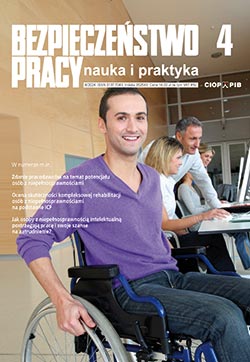Acoustics of silence
Adam Lipowczan
Previous themes of most scientific conferences, as well as publications addressing issues of noise have focused on SPL intervals: of danger (80-130 dB) and to a lesser extent of annoyance (45-80 dB). In the last two years, there have been a series of studies on to the range of acoustic comfort (20-45 dB). The paper discusses the importance of this range in several approaches (physical, metrological, legal). It also presents selected issues on very low sound pressure levels (below 20 dB).
DOI: 10.5604/01.3001.0013.1975
Limiting exposure to noise of miners servicing conveyor belts by situating their workstations within technological recesses
Janusz Kompała, RAFAŁ WIŚNIOWSKI
The article presents a method of limiting exposure to noise in the vicinity or workstations of conveyor drive services. This is done by setting up the conveyor belt personnel’s workstations within special technological recesses. The core of the presented solution consists in the design of an optimal set up of the technological recess, which in turn has enabled the realisation of production activities with OSH taken into account. The necessary requirement was a simultaneous achievement of the value of the equivalent noise level A LAeq below the value of relevant health standards. The results of the measurement were superimposed on the schematics of the mining excavation, and thus decided about the placement of the solution. New workstations were created and located according to the same schematics with the use of one-way exit with roof and the front wall and the side walls made of straight cross-bars of V29 profiles. Additionally, to improve the acoustic climate, the constructed technological recesses went through the acoustic adaptation performed with the use of sound absorbing material. The solution has been implemented in Węglokoks Kraj Sp. z o.o. KWK „Bobrek - Piekary”.
The obtained results, which were collected before and after the use of the described solution, have confirmed the effectiveness of this approach. The level of exposure to noise related to 8-hour working time (LEX, 8h) has been reduced from 86,3 to 81,3 dB.
DOI: 10.5604/01.3001.0013.1976
Mobile test setup for visualization of acoustic fields surrounding machines
Grzegorz Szczepański, Leszek Morzyński, Dariusz Pleban
Visualization of the parameters of acoustic field is a relatively new research technique that allows for illustrate the parameters characterizing the acoustic field for specific points of space near the machine. Images obtained in this way have many applications in the analysis of prototype devices, construction, as well as in the analysis of the acoustic field around industrial machines. The article presents the principles of operation of the mobile experimental setup. The results of studies of noise emission on the example of loudspeaker set and vacuum pump are also discussed.
DOI: 10.5604/01.3001.0013.1977
Transmission of information about danger to an employee equipped with an individual vibrating warning system
Rafał Młyński, Emil Kozłowski, Leszek Morzyński
The use of hearing protectors is a frequent way to avoid the impact of noise present in the work environment. However, it should be kept in mind that the use of hearing protectors, while reduces the threat created by noise, also diminishes the perception of sounds that are important for the safety of the employee. In such cases, employee’s safety can be improved/increased by using a system to detect the near presence of a moving vehicle. Such a system should be able to transmit information on detected danger to an employee using hearing protectors. The article discusses the possible ways of providing such information to employees using hearing protectors. The advantages and disadvantages of using acoustic, light and vibration signals for this purpose were considered. The authors also present original research results to confront the possibility of perceiving the vibration signal produced by two types of wearables.
DOI: 10.5604/01.3001.0013.1978
A measurement study ear simulators being in use in Poland and the influence of their acoustic parameters on hearing tests
ALEKSANDRA MŁYŃSKA, DANUTA DOBROWOLSKA
Ear simulators are used for traceable calibration and testing of audiometric equipment. They should be periodically calibrated because their parameters can change over time affecting the results of audiometric equipment calibration and, consequently, the results of hearing tests and assessment. During calibration two acoustic parameters are determined: the overall pressure sensitivity level of the ear simulator system and acoustical impedance of the ear simulator, which is additionally assessed in terms of compatibility with IEC 60318-1:2009. The sensitivity level is used for assuring traceability of measurements while acoustical impedance provides information on the condition of a given ear simulator. There are two objectives of this paper. The first is to show how a change in acoustical impedance influences the response of the ear simulator system to a signal from an audiometric earphone. The other is to present the results of a measurement study on acoustic parameters of ear simulators in use in Poland. The article presents the results of measurements of the sensitivity level and acoustical impedance of ear simulators, and the assessment of simulators in the term of their suitability for calibration of audiometric equipment.
DOI: 10.5604/01.3001.0013.1979




























